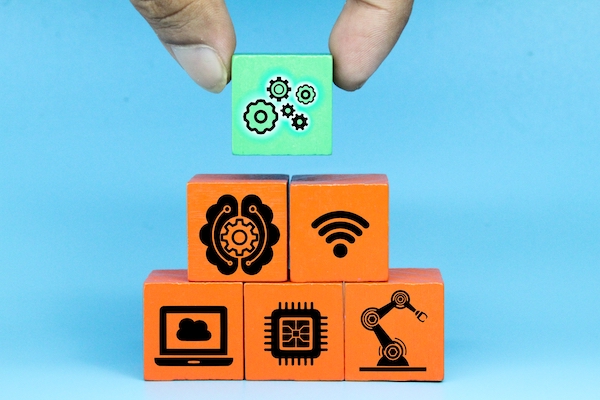ERP software helps improve business operations by connecting the enterprise from end to end, providing real-time access to data, streamlining processes, and providing greater insight. When IoT technologies get integrated with ERP, more data is available to leverage. The increased data provides a deeper look into what is happening within the company and with other things such as the supply chain. The takes information from theInternet of Things (IoT)and translates it into useful analytics that help inform decision-making.

How does IoT work and how is it used?
IoT is a collection of interconnected physical devices that can monitor, report on, and send and exchange data. The devices capture data that otherwise would not be available. For instance, on the manufacturing production line, machines can provide information through embedded sensors about their maintenance needs and the production process. Handheld devices can scan RFID (radio frequency identification) tags to track inventory. And items with built-in sensors can be monitored using GPS and other technologies as they move from one stage to another in the supply chain.
What are the benefits of integrating ERP and IoT?
There are many ways IoT works with ERP to help businesses. Leveraging IoT data provides companies with critical business information that can increase efficiency, productivity, and quality. Let’s look at the main benefits of integration with IoT and ERP.
- Greater supply chain management – Using smart sensors, IoT can provide information on the exact condition of inventory. Companies can learn how physical and environmental factors impact their assets. They can determine if any problems occurred such as damaged packaging and if weather conditions were a factor such as damage due to humidity.
The movement of items gets monitored during their journey so businesses are kept up-to-date on their location. IoT can also send information from vehicles transporting supplies and if any routes get impacted due to weather or traffic issues, they can be rerouted. When items get received, this can trigger other tasks like supplier payments or onward shipping requests. With real-time location tracking, warehouse employees can quickly find items.
Information gets obtained faster than with manual methods to reduce supply-chain cycles. Knowing the status of inventory helps to confidently carry out orders. Since inventory is tracked as it is moved, it helps to reduce the chance of being lost or stolen. IoT allows the supply chain to be more transparent and efficient.
- Increased insight – With access to greater amounts and higher quality data, IoT helps facilitate better business decisions. ERP takes the big data provided by IoT and transforms it into actionable information. This information is transmitted to the appropriate people so they can respond as needed. Businesses can be more proactive by receiving information before problems occur.
- Improved shop floor performance– ERP automates manual processes, but IoT goes even further. Certain tasks that were previously too intricate or interconnected to be automated are now able to be with IoT. IoT minimizes the role of manual labor and improves productivity. It allows ERP to have real-time production visualization and simplifies operations to provide step-by-step procedures. The increased automation provided with IoT helps to streamline activities, reduce waste, and improve profitability.
- Enhanced forecasting – It’s important companies can successfully plan for the future. When ERP is integrated with IoT, greater information is available about how customers are finding, buying, and using products and services. IoT data can help businesses identify patterns to make informed decisions around production. The added information helps businesses improve the accuracy and effectiveness of forecasting and planning.
- Better quality –By using sensors on manufacturing lines, any defects or misalignments of work in progress get detected immediately and corrected. Companies that use sensors on their products can learn more about product usage to identify changes needed to improve quality. The sensors can also detect product deficiencies so businesses can reach out to customers or notify their service reps to proactively correct problems before they may even be noticed.
- Improved asset maintenance–With sensors connected to production machines, alerts get sent to the ERP system to indicate if there are any performance issues. It also helps equipment technicians locate the exact area of a problem. The sensors provide notifications for when machines are due for maintenance to help keep them in top operating condition. Predictive rather than preventive maintenance gets utilized which allows machines to be maintained only when it is predicted they will have a malfunction or failure. Whereas preventive maintenance has equipment scheduled for upkeep regularly regardless if the equipment is having an issue. Predictive maintenance lets you monitor, maintain, and optimize assets for better availability, utilization, and performance. It lowers maintenance costs and extends the life of your assets.
- Increased environmental sustainability/energy management–IoT helps businesses be more environmentally friendly. It automates processes so they are faster and more efficient to reduce waste and emissions. IoT sensors detect leaks like gas to prevent waste or pollution. It collects data so resources can be used more efficiently and components and materials can be reused. It optimizes truck routes to reduce the amount of fossil fuel used. And, it recognizes the most energy-efficient ways to operate machines to minimize carbon footprint.
What are the challenges of integrating IoT with ERP?
While there are many benefits of IoT integrated with ERP, there are also some challenges. The integration of these technologies can present some obstacles to overcome.
- Security threats –As with anything connected to the internet, the opportunity exists for security breaches. But, two-factor authentication and IT security software can help avoid these threats. As with any technology, you must take precautions to ensure it is not vulnerable to any negative activity.
- Connectivity issues – To use IoT it’s important to have a stable internet connection. If it is being used to track vehicles, may not always be in a location with a reliable network. Bandwidth is another connectivity factor. The more IoT is used, the more bandwidth is needed to support the consumption of connected platforms.
- Legacy equipment – If you are working with older equipment, it can be more challenging to implement IoT, but it may be all the more reason to do so. IoT helps to effectively maintain equipment. Its sensors deliver new information and new context about the equipment to help run it more efficiently. It lowers the cost of maintenance by predicting machine failures to alleviate unplanned downtime.
- Cost –IoT application pricing has become lower in recent years and sensors are not very expensive. But, if you are using older machinery and want to add a sensor to it, you may need to have the machinery retrofitted to work with the sensor. It may make sense to replace the equipment to better accommodate IoT technology, depending on the cost and the type of equipment. High-speed internet and cloud-based network infrastructure is needed to ensure reliable connectivity. And, unless you have someone in your organization who is familiar with this technology, you will need to hire someone to help implement it.
Is the integration of IoT with ERP worth it?
It’s expected that by 2025 there will be 38.6 billion IoT devices worldwide. Determine if integrating IoT with ERP is worth the time and the cost depends on many factors. It will depend on the size of the business, the type of industry if the existing ERP system is compatible with IoT technology, and more. Companies need to look at the benefits they can gain vs. the costs to implement to make that determination.
It may seem like IoT is best suited for large companies but, it is often a perfect fit for small and midsize manufacturers. Especially if they have complex processes and if their machines are critical to performance and quality. Many IoT vendors provide a modular approach to phase deployment of IoT. For any size business, it’s best to start small and focus on what will provide the greatest impact first.
The benefits of IoT are many and it can unlock valuable analytics by feeding previously inaccessible data into an ERP system. ERP can use that information to help a business increase productivity, lower costs, and better compete.







